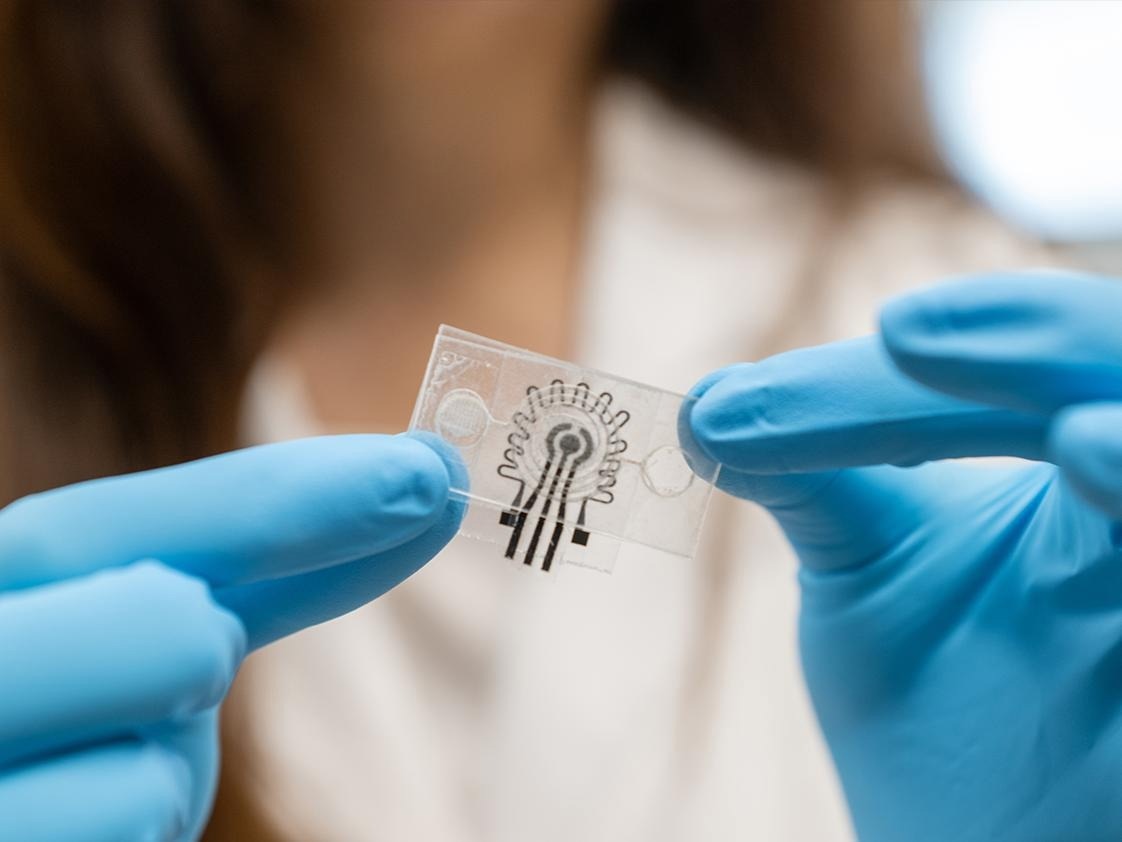
Penn State researchers developed a new wearable sensor to monitor glucose levels in sweat over multiple weeks. Image Credit: Kate Myers/Penn State
Constructed from a laser-modified graphene nanocomposite material, this device has the capability to monitor sweat-based glucose levels continuously for three weeks. Simultaneously, it can also track body temperature and pH levels, as outlined in the findings reported in Advanced Functional Materials.
Sweat is ideal for real-time, continuous, and non-invasive biomarker detection. But low biomarker concentration levels in sweat and variability of other factors such as pH, salinity, and temperature have pushed previous sweat biosensors past the limits of their detection and accuracy.
Huanyu “Larry” Cheng, Study Principal Investigator, James L. Henderson Jr. Memorial Associate Professor, Engineering Science and Mechanics, Pennsylvania State University
Cheng added, “This device is able to account for this variability while measuring glucose with needed specificity for weeks at a time.”
Cheng and his fellow researchers recognized, based on their prior work with sensors and insights gleaned from the research of others, that electrodes made of laser-induced graphene (LIG) held promise as a starting point for developing a more efficient sweat sensor. LIG electrodes are crafted using a nanomaterial created in a single step through laser scribing.
Despite their drawbacks, such as low sensitivity to glucose and a limited electrochemical surface area, Cheng pointed out that LIG electrodes possess notable advantages: they are straightforward to produce, cost-effective, and flexible.
Operating at the nanoscale, the researchers reported employing a straightforward laser treatment technique to establish a stable, three-dimensional network comprising highly conductive noble metal alloys—specifically, gold and silver—combined with carbon-based nanocomposite materials on the porous LIG electrode. Cheng highlighted that noble metals offer not only high conductivity but also exceptional resistance to oxidation.
Through a straightforward laser treatment, Cheng explained that the gold and silver alloy nanocomposite material can be heated to resist agglomeration, which is a typical occurrence where nanoparticles gather into clusters, consequently restricting the material's available surface area.
Glucose on the surface of the modified LIG electrode oxidizes at lower potential. This oxidation generates a measurable current or potential change that is directly proportional to the overall glucose concentration in the solution.
Farnaz Lorestani, Study Author and Postdoctoral Scholar, Engineering Science and Mechanics, Pennsylvania State University
Lorestani added, “We also see far greater stability over time, with the laser-treated sensor losing only 9% of its sensitivity over three weeks compared to 20% sensitivity loss for a sensor without laser treatment.”
Furthermore, the researchers noted that the modified LIG electrode exhibited responsiveness to changes in pH levels.
To construct the wearable device, they integrated the dual glucose and pH sensor with another temperature sensor based on LIG technology. They also incorporated a stretchable layer featuring coil-shaped microfluidic channels, enabling continuous sweat collection and routing for sampling purposes.
This device offers the capability to calibrate glucose measurements based on variations in sweat pH and body temperature stemming from activities such as exercise and eating, as explained by Cheng.
Designed as a patch roughly twice the width of a postage stamp and adhered to the skin using adhesive tape, it can wirelessly transmit the collected data to a computer or mobile device for real-time monitoring and analysis.
The result of our work is a sensor with the notable sensitivity and stability to monitor glucose levels over multiple weeks. It is a low-cost platform offering convenient, accurate, and continual analysis of sweat in diverse conditions, which has great potential for individual and population health, personalized medicine, and precision nutrition.
Huanyu “Larry” Cheng, Study Principal Investigator, James L. Henderson Jr. Memorial Associate Professor, Engineering Science and Mechanics, Pennsylvania State University
Research contributors from ESM include graduate students Abu Musa Abdullah, Shishir Barai, Md Abu Sayeed Biswas, Shuvendu Das, Ankan Duta, Bowen Li, Yushen Liu, Zhenyan Niu, MD Mashfiqur Rahman, Xin Xin, and Xianzhe Zhang; Ke Wang, Associate Research Professor, from the Penn State Materials Research Institute. Duta is also associated with the Penn State Center for Neural Engineering.
The study was financially supported by the National Institutes of Health and the National Science Foundation.
Journal Reference
Lorestani, F., et al. (2023) A Highly Sensitive and Long-Term Stable Wearable Patch for Continuous Analysis of Biomarkers in Sweat. Advanced Functional Materials. doi.org/10.1002/adfm.202306117